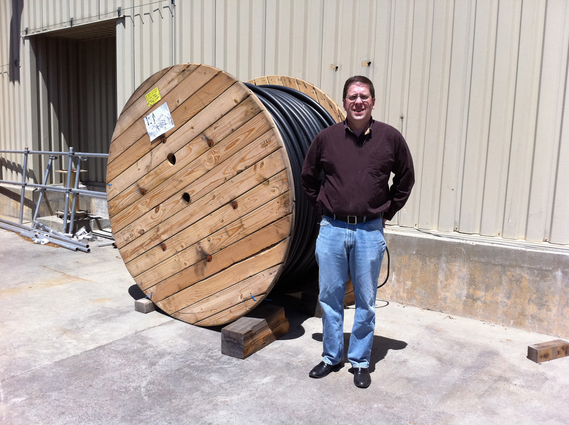LLNL scientists contributed to the latest Higgs Boson results announced by CERN
 (Download Image)
Lab physicist Jeff Gronberg at SLAC with the special low-loss RF cable now being used for the 10 picosecond timing system, a part of the CMS detector upgrade.
(Download Image)
Lab physicist Jeff Gronberg at SLAC with the special low-loss RF cable now being used for the 10 picosecond timing system, a part of the CMS detector upgrade.
The new evidence resulted from the analysis of additional data from the ATLAS and CMS collaborations at the Large Hadron Collider (LHC) -- data that was not yet available at the time of the July 2012 announcement of the particle's discovery. A Toroidal LHC Apparatus, or ATLAS, and the Compact Muon Solenoid (CMS) are detectors for recording and measuring particle collisions inside the LHC, the world's largest and most powerful particle accelerator.
Researchers unveiled the new evidence with much fanfare at the Moriond conference in La Thuile, Italy March 7.
"These new results are pretty impressive, adding not just more statistics, but new information showing that we have a Higgs boson," said Doug Wright who leads the Lab's CMS team. "The exact properties of this boson and whether other Higgs bosons are lurking out there are the next order of business for the LHC. Ultimately this will tell us something about the evolution of the universe and perhaps a clue towards a Grand Unified Theory."
The LLNL team contributed to the trigger system in the detector that captures particles and other physics events. Lab scientists also played a leading role in the development of the software that reconstructs the raw data into the physics objects that are the basis of all analysis.
"We are now working on a novel physics analysis that can detect the presence of new particles and reveal information about the Higgs," Wright said. "This new approach takes advantage of a special subset of LHC collisions in which the primary protons remain intact. One of the attractive features of this approach is that it is sensitive to new physics effects that the main LHC analyses would miss."
Members of the Lab's CMS team in addition to Wright are David Lange, Jeff Gronberg and postdoc Finn Rebassoo. Former LLNL postdocs currently on CMS are Jonathan Hollar (now at University of Louvain, Belgium) and Bryan Dahmes (now at University of Minnesota). Livermore joined CMS in 2005. The new evidence appears to confirm that the 2012 discovery was indeed a Higgs boson, though researchers as yet know too little about the particle's properties to be able to determine what kind of a Higgs boson it is, according to the press announcement from CERN. Nor do researchers know if there is only one Higgs boson, as predicted by the Standard Model, or a range of bosons postulated by more speculative theories.
CMS is a general purpose detector designed to investigate a wide range of physics phenomena including the search for the Higgs boson, extra dimensions and evidence of dark matter. The hulking 20,000-ton detector is built around a mammoth solenoid magnet made up of a cylindrical coil of superconducting cable that can generate a magnetic field 100,000 times that of the Earth's. The CMS experiment is one of the largest international scientific collaborations in history, involving 4,300 particle physicists, engineers, technicians, students and support staff from 179 universities and institutes in 41 countries. The LHC is located at the CERN (European Organization for Nuclear Research) center near Geneva, Switzerland.
For more on the Lab's role in the LHC project, see these previous Newsline stories here and here .
Contact
Donald B Johnston[email protected]
925-423-4902
Tags
Physical and Life SciencesFeatured Articles







